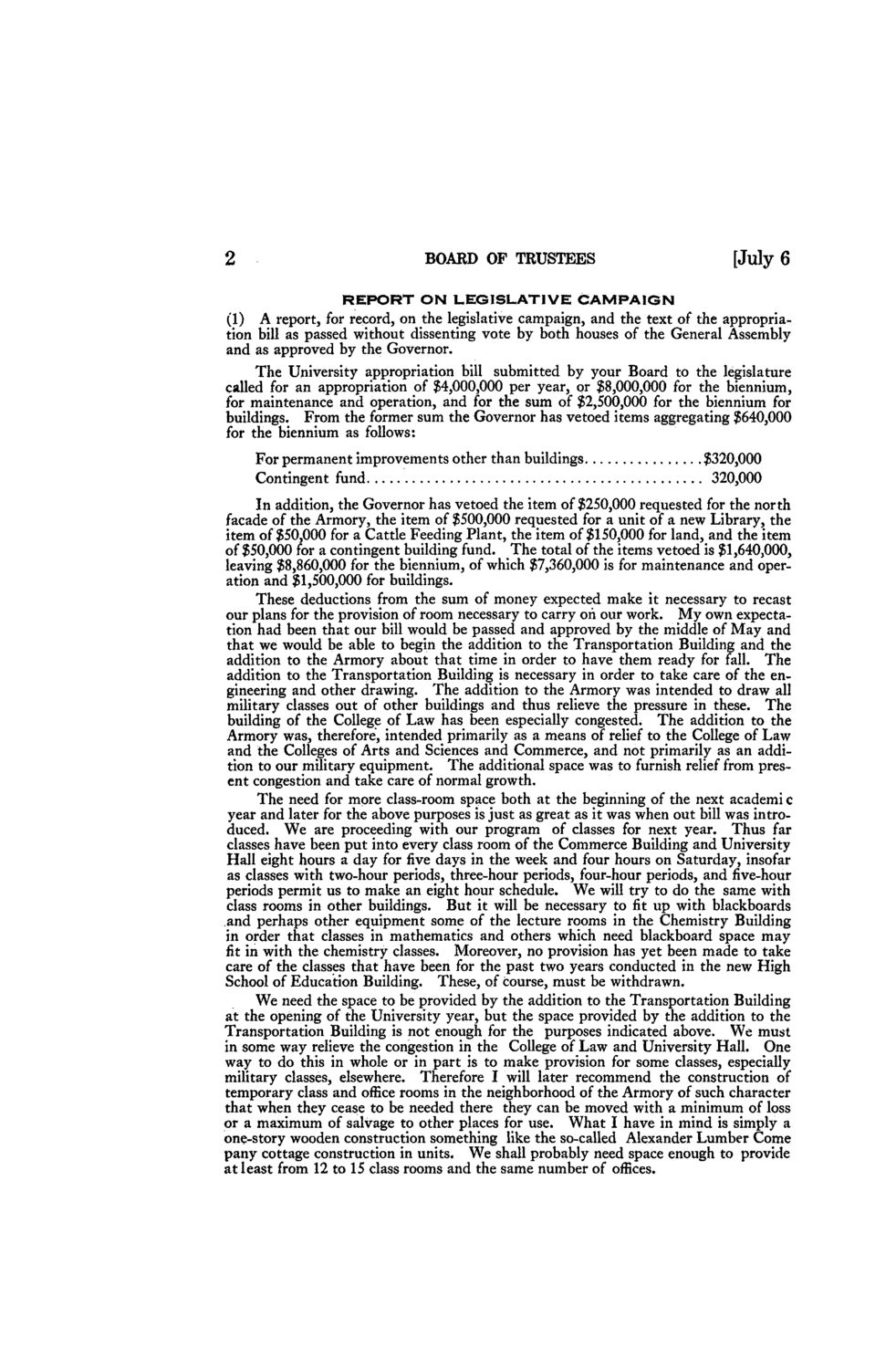| |
| |
Caption: Board of Trustees Minutes - 1922
This is a reduced-resolution page image for fast online browsing.

EXTRACTED TEXT FROM PAGE:
2 BOARD OF TRUSTEES [July 6 REPORT O N LEGISLATIVE CAMPAIGN (1) A report, for record, on the legislative campaign, and the text of the appropriation bill as passed without dissenting vote by both houses of the General Assembly and as approved by the Governor. The University appropriation bill submitted by your Board to the legislature called for an appropriation of $4,000,000 per year, or $8,000,000 for the biennium, for maintenance and operation, and for the sum of $2,500,000 for the biennium for buildings. From the former sum the Governor has vetoed items aggregating $640,000 for the biennium as follows: For permanent improvements other than buildings Contingent fund $320,000 320,000 In addition, the Governor has vetoed the item of $250,000 requested for the north facade of the Armory, the item of $500,000 requested for a unit of a new Library, the item of $50,000 for a Cattle Feeding Plant, the item of $150,000 for land, and the item of $50,000 for a contingent building fund. The total of the items vetoed is $1,640,000, leaving $8,860,000 for the biennium, of which $7,360,000 is for maintenance and operation and $1,500,000 for buildings. These deductions from the sum of money expected make it necessary to recast our plans for the provision of room necessary to carry oh our work. My own expectation had been that our bill would be passed and approved by the middle of May and that we would be able to begin the addition to the Transportation Building and the addition to the Armory about that time in order to have them ready for fall. The addition to the Transportation Building is necessary in order to take care of the engineering and other drawing. The addition to the Armory was intended to draw all military classes out of other buildings and thus relieve the pressure in these. The building of the College of Law has been especially congested. The addition to the Armory was, therefore, intended primarily as a means of relief to the College of Law and the Colleges of Arts and Sciences and Commerce, and not primarily as an addition to our military equipment. The additional space was to furnish relief from present congestion and take care of normal growth. The need for more class-room space both at the beginning of the next academi c year and later for the above purposes is just as great as it was when out bill was introduced. We are proceeding with our program of classes for next year. Thus far classes have been put into every class room of the Commerce Building and University Hall eight hours a day for five days in the week and four hours on Saturday, insofar as classes with two-hour periods, three-hour periods, four-hour periods, and five-hour periods permit us to make an eight hour schedule. We will try to do the same with class rooms in other buildings. But it will be necessary to fit up with blackboards and perhaps other equipment some of the lecture rooms in the Chemistry Building in order that classes in mathematics and others which need blackboard space may fit in with the chemistry classes. Moreover, no provision has yet been made to take care of the classes that have been for the past two years conducted in the new High School of Education Building. These, of course, must be withdrawn. We need the space to be provided by the addition to the Transportation Building at the opening of the University year, but the space provided by the addition to the Transportation Building is not enough for the purposes indicated above. We must in some way relieve the congestion in the College of Law and University Hall. One way to do this in whole or in part is to make provision for some classes, especially military classes, elsewhere. Therefore I will later recommend the construction of temporary class and office rooms in the neighborhood of the Armory of such character that when they cease to be needed there they can be moved with a minimum of loss or a maximum of salvage to other places for use. What I have in mind is simply a one-story wooden construction something like the so-called Alexander Lumber Come pany cottage construction in units. We shall probably need space enough to provide at least from 12 to 15 class rooms and the same number of offices.
| |